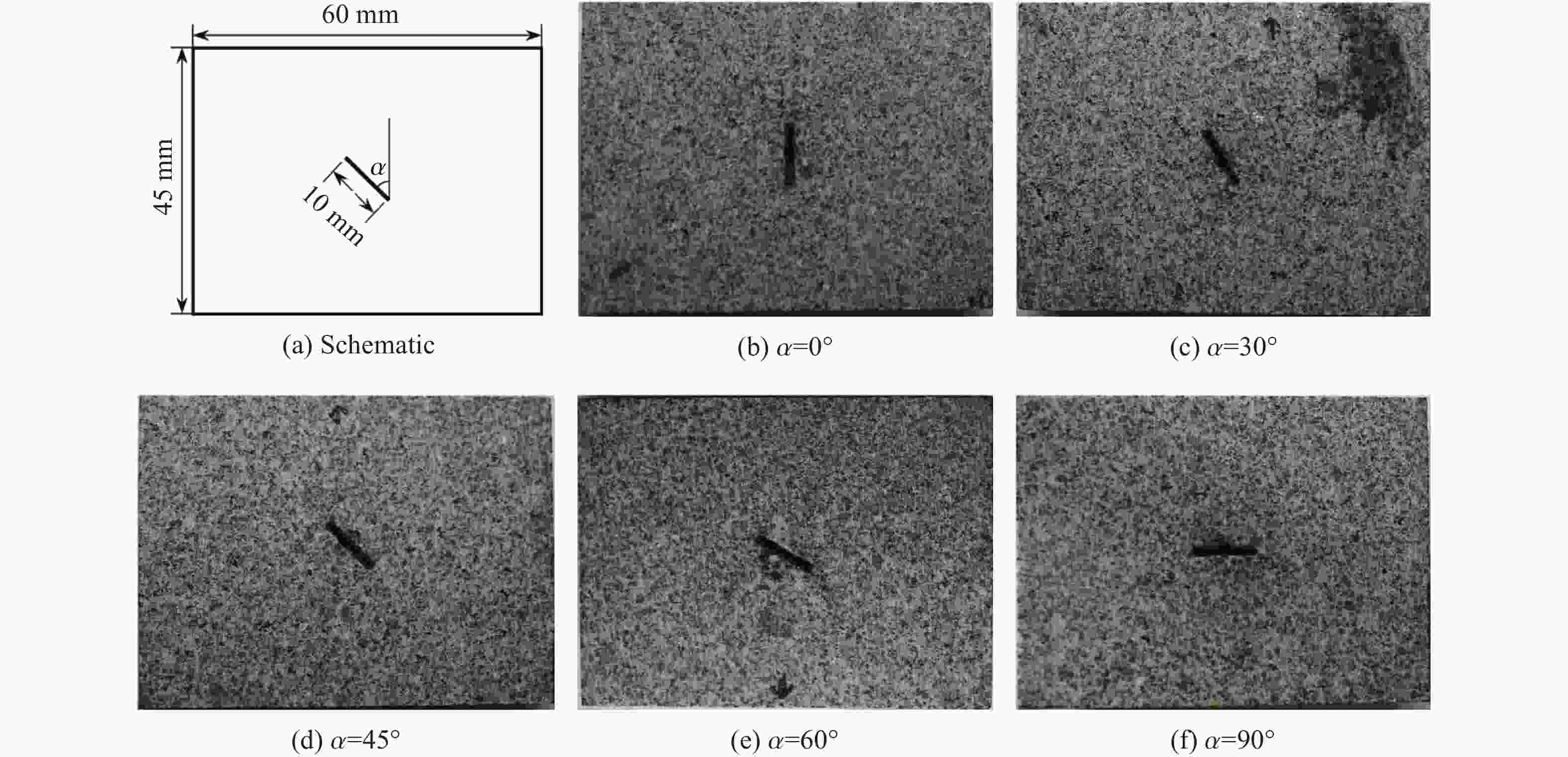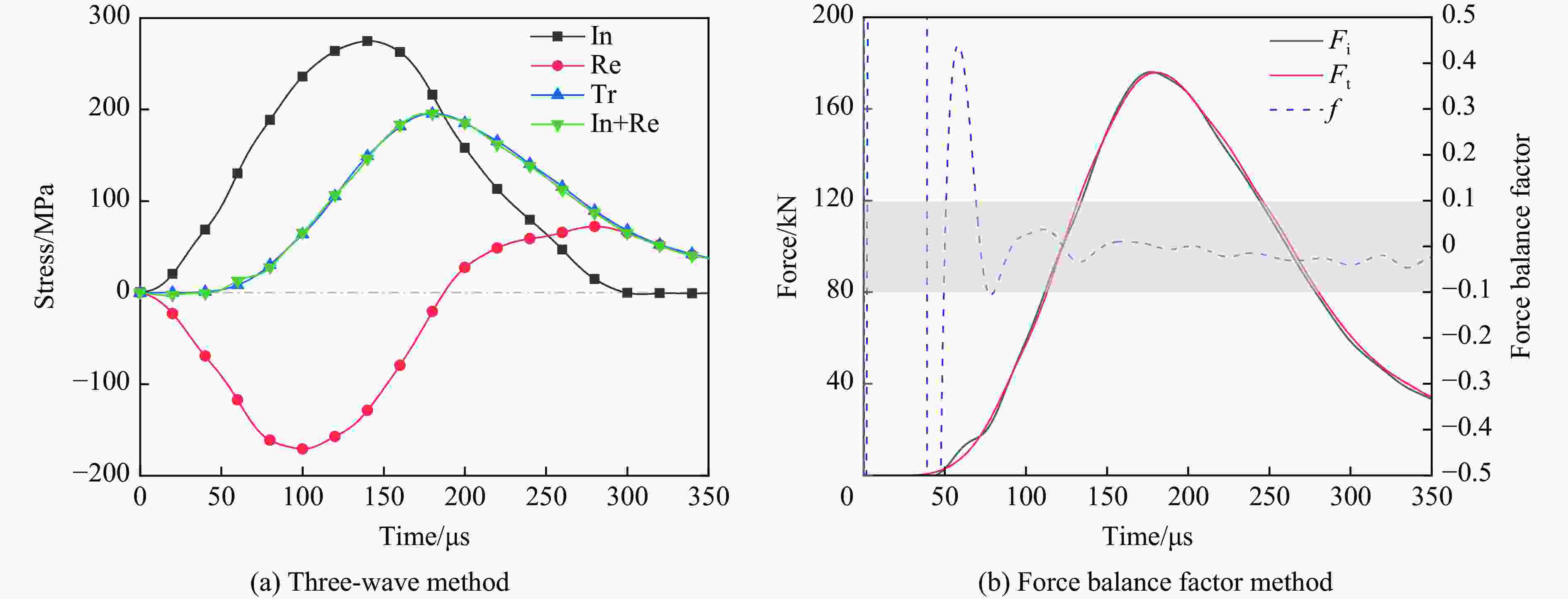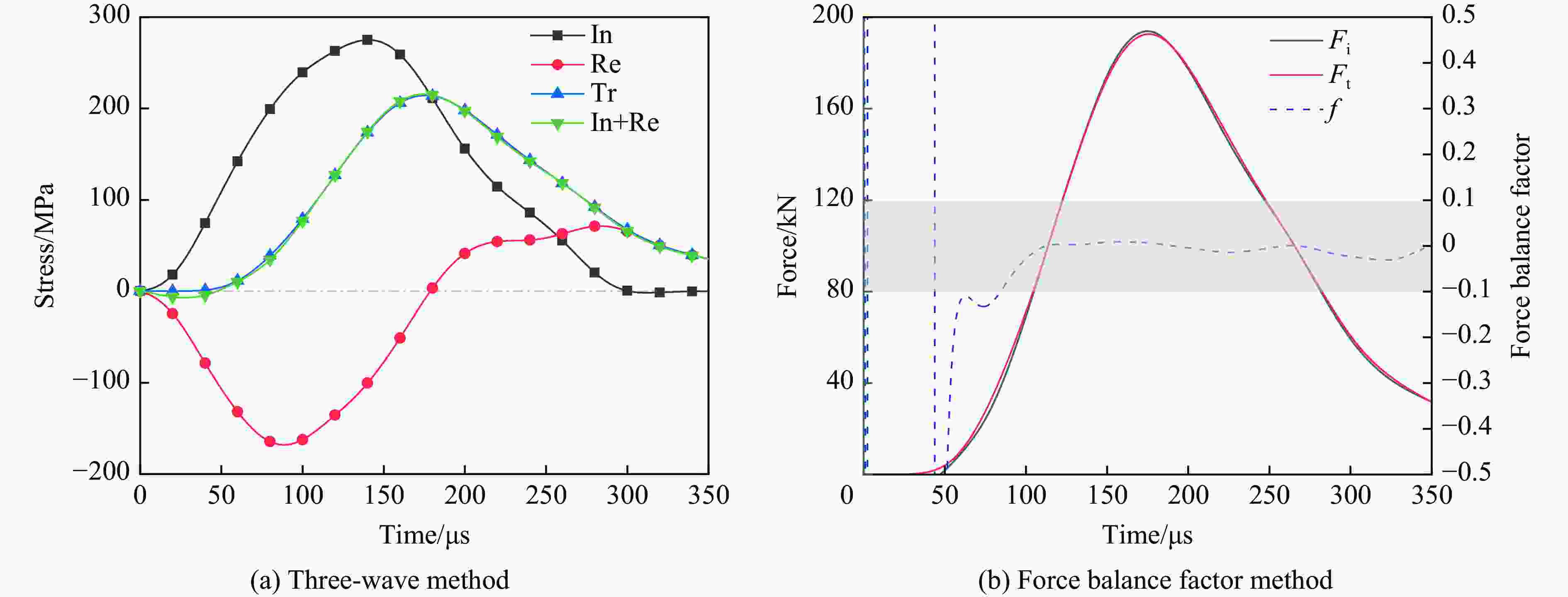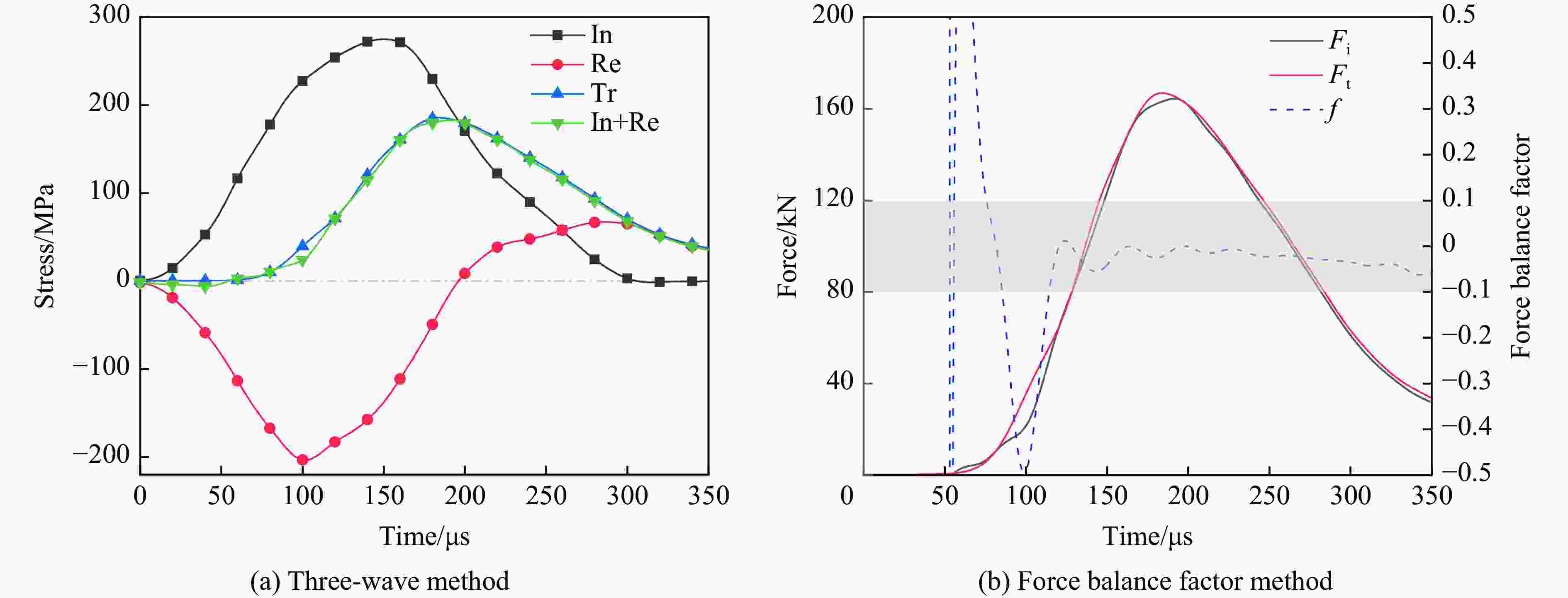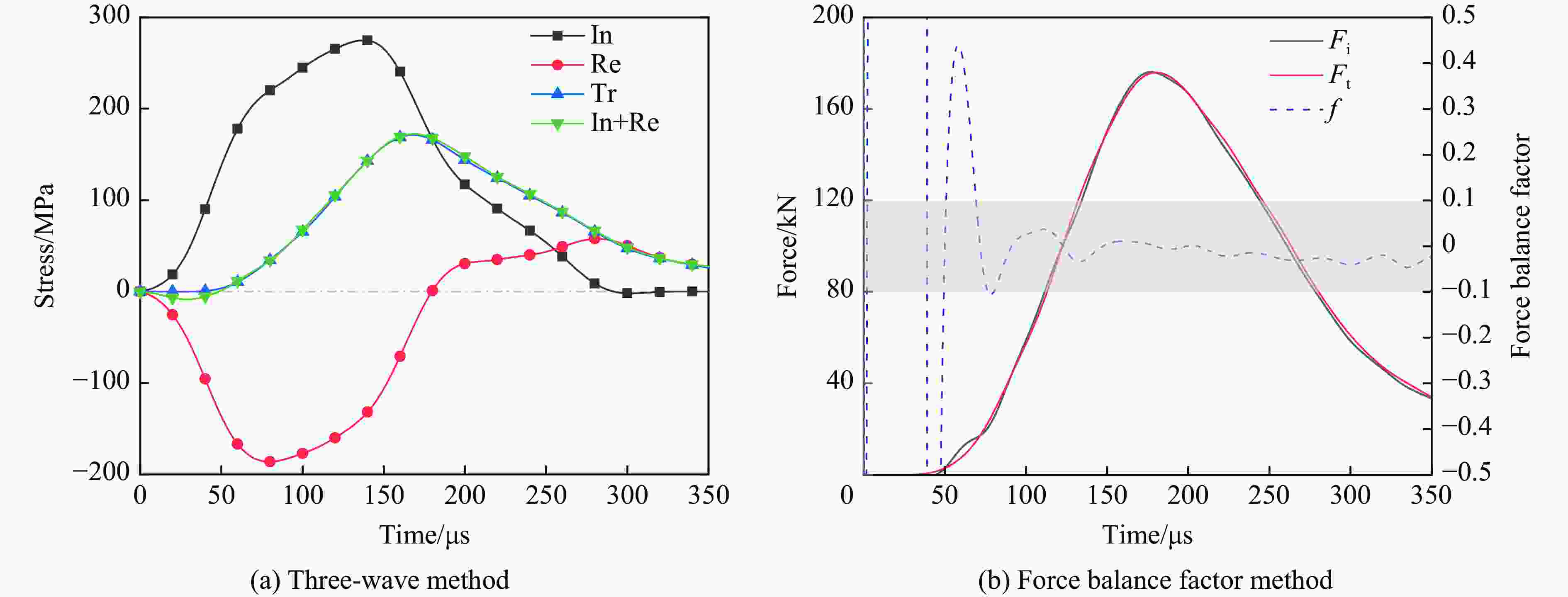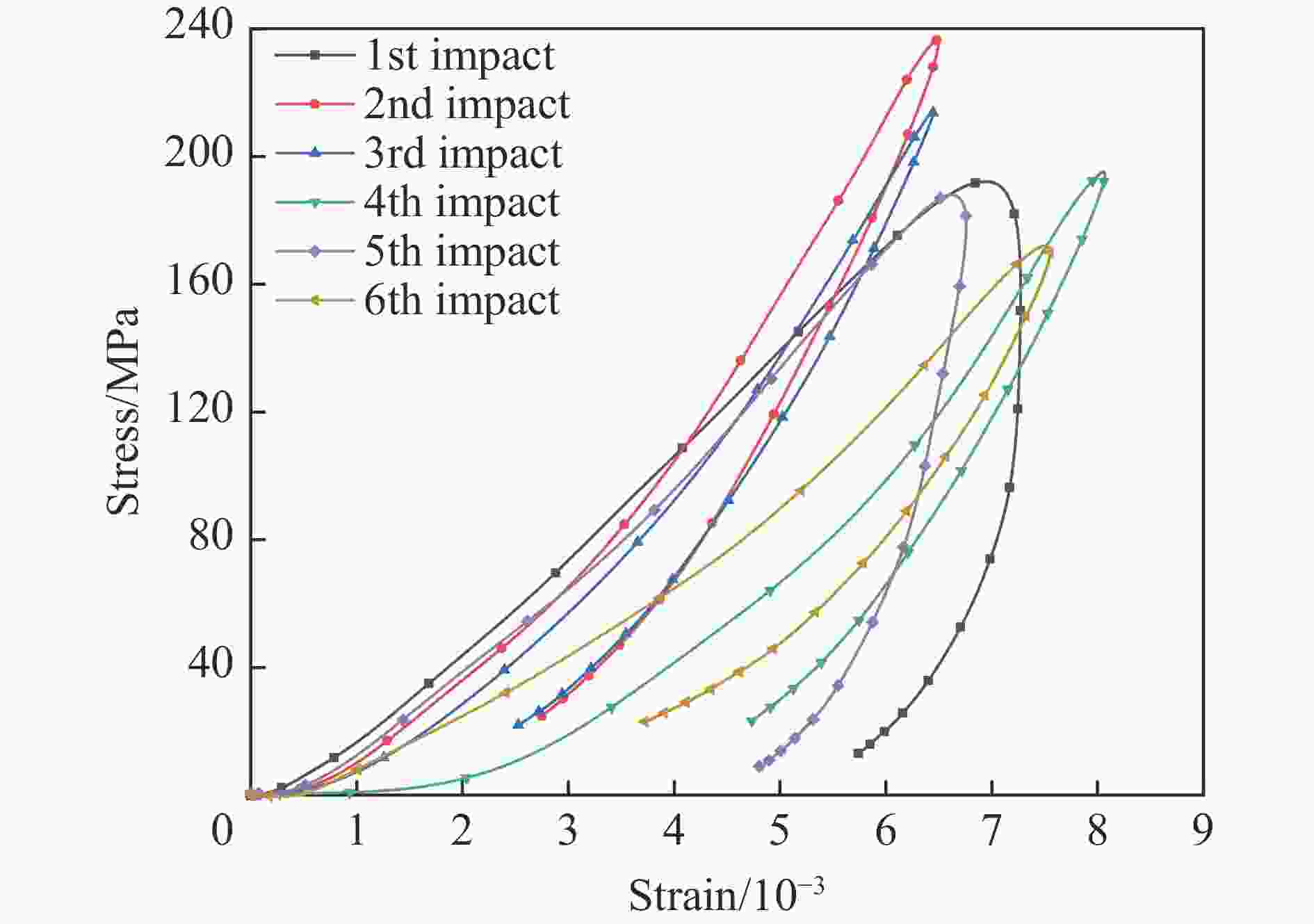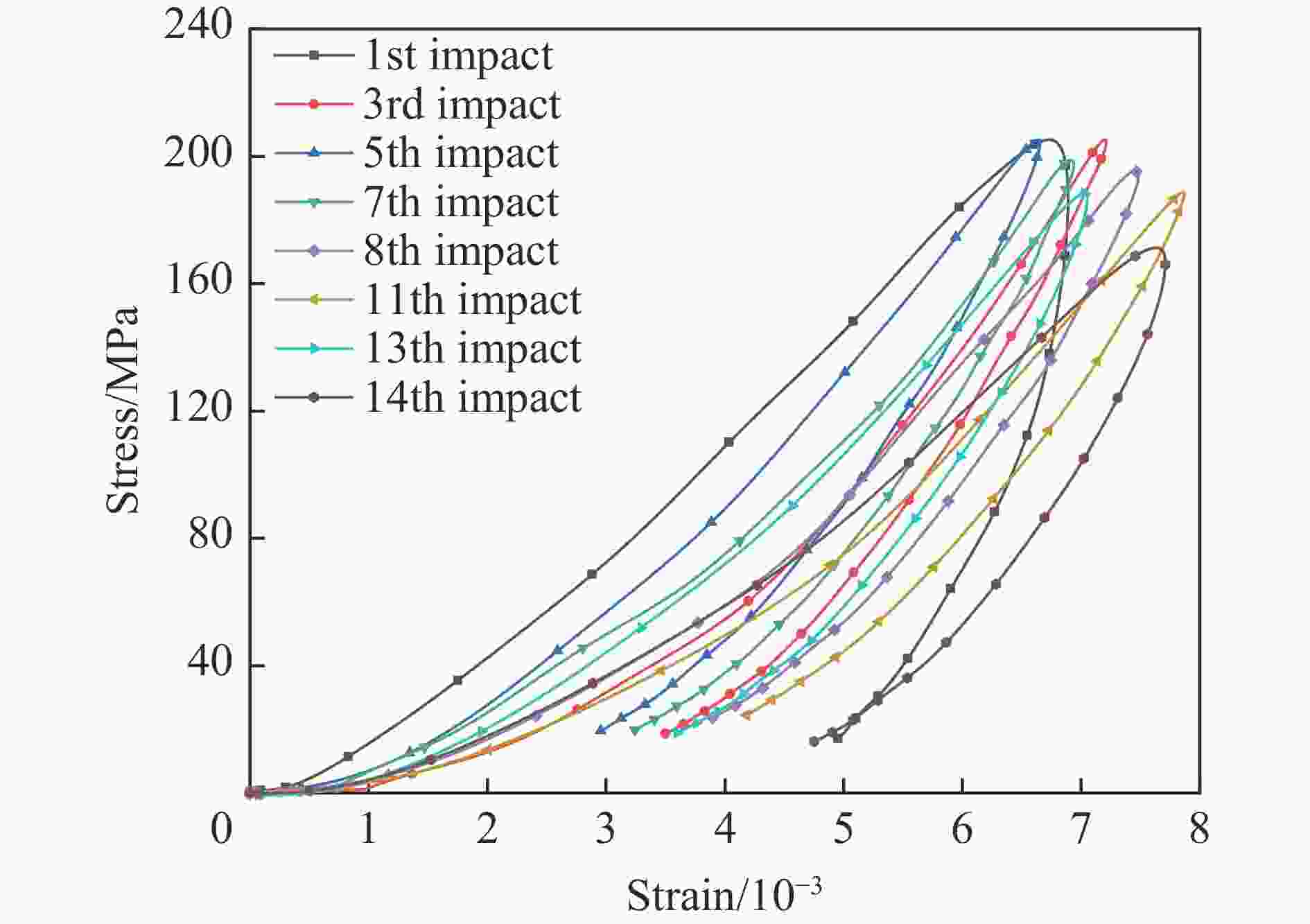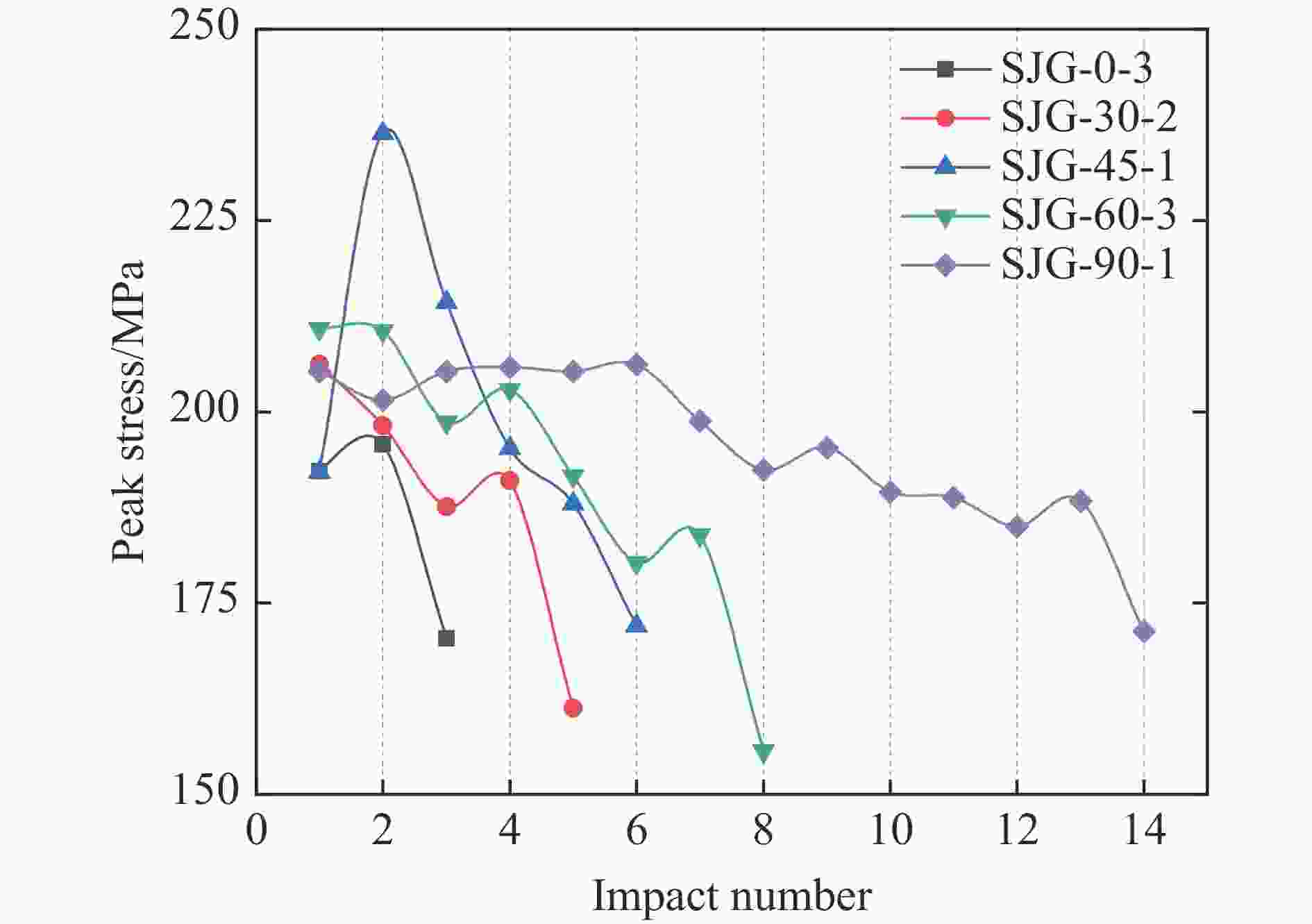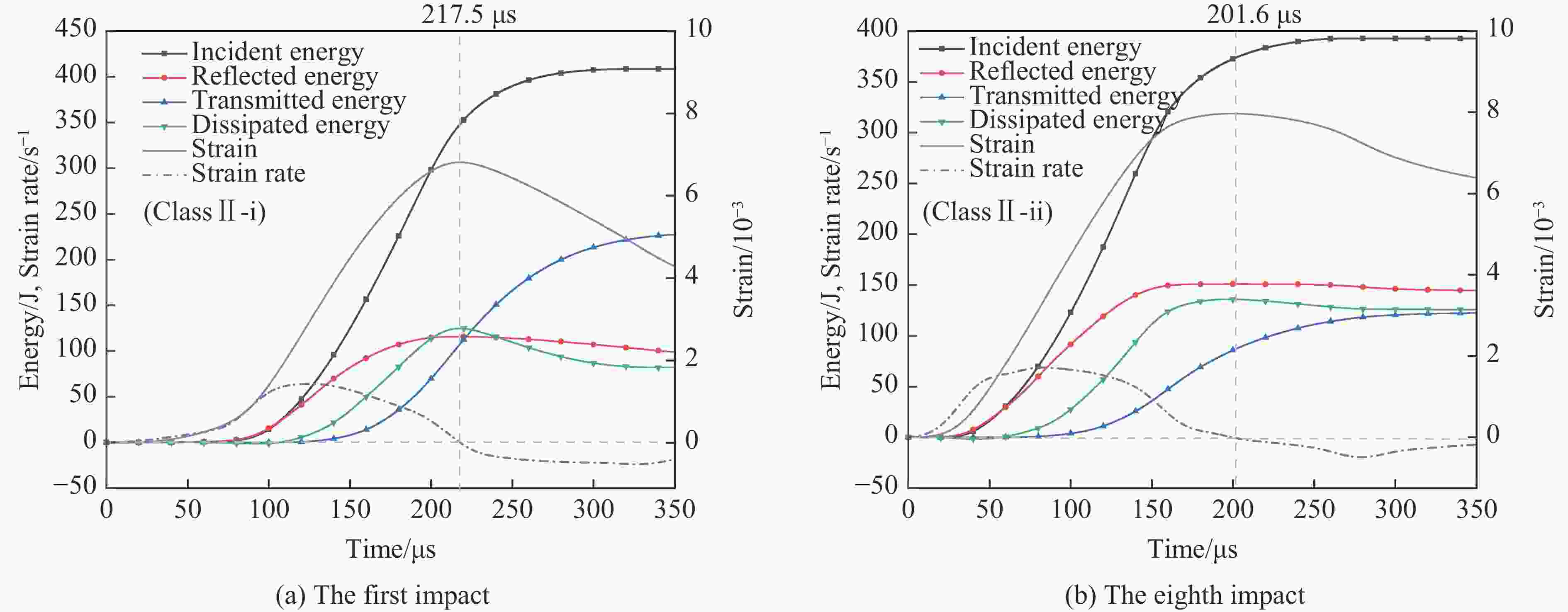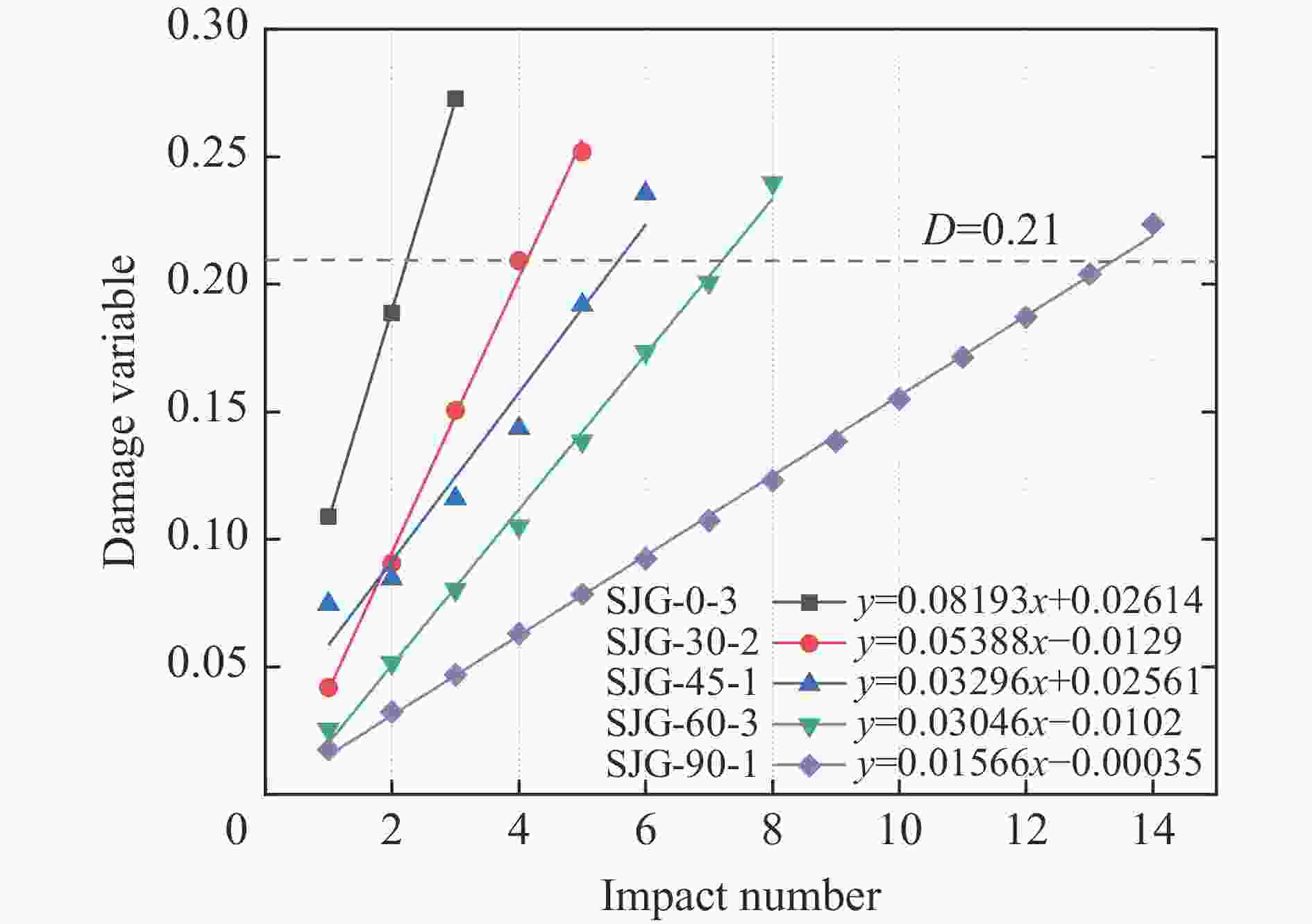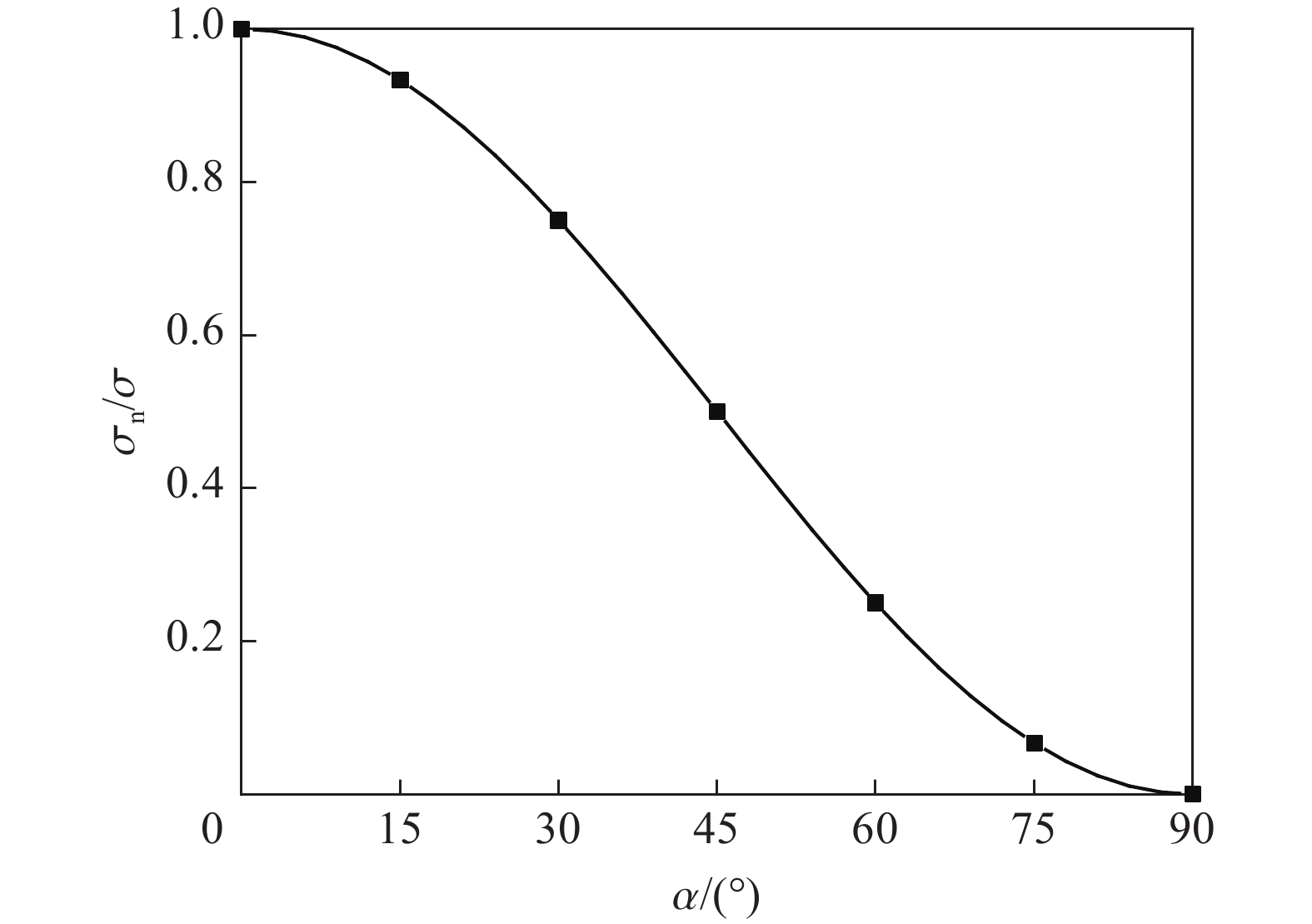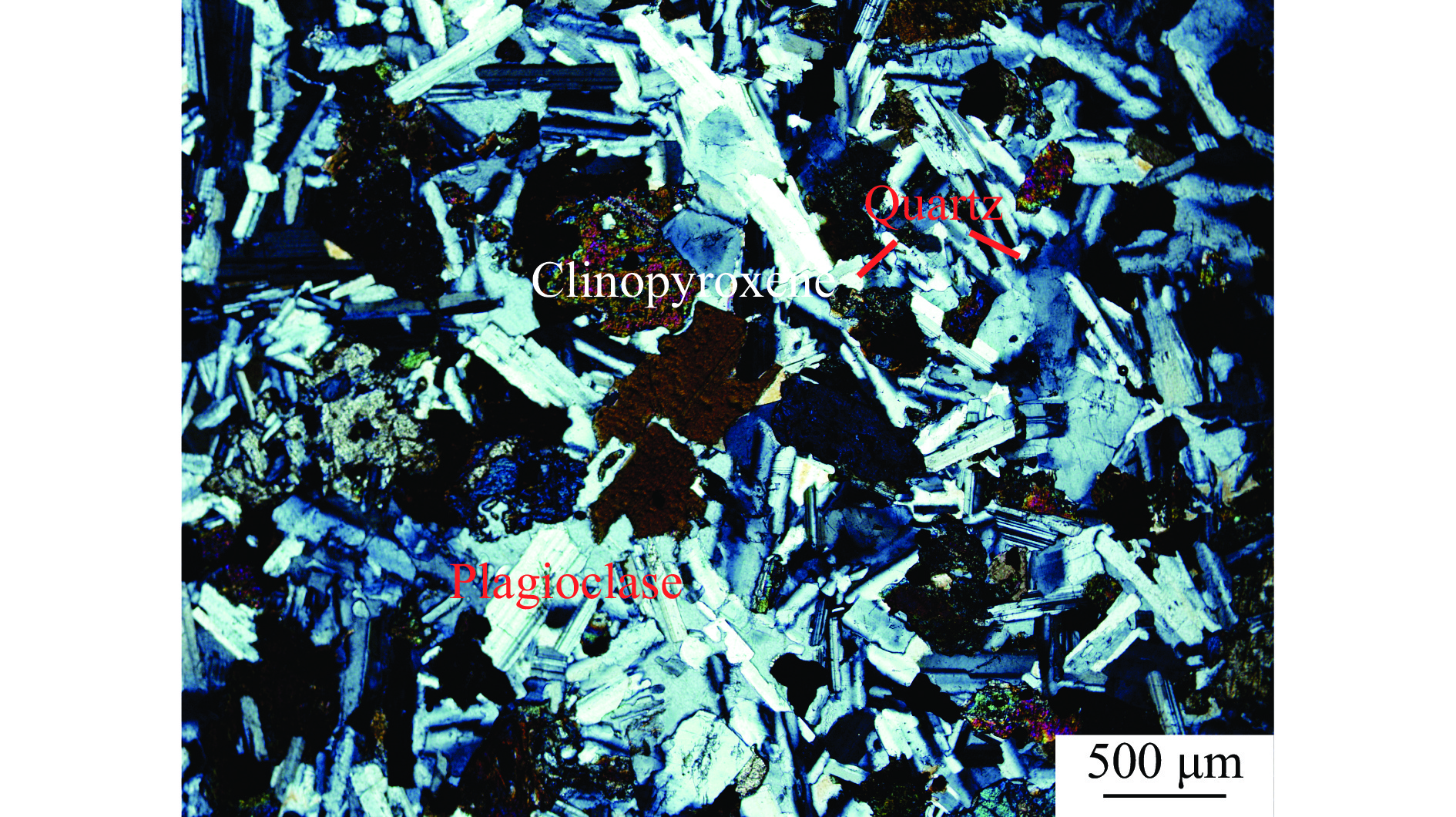Dynamic mechanical behaviors of single-jointed rock mass under cyclic impact loadings
-
摘要: 为探究节理岩体在循环动力扰动作用下的动态力学行为,采用分离式霍普金森压杆试验系统,对含单节理辉长岩试件进行了单轴循环冲击试验,从试件的抗冲击能力、应力应变性质、能量和损伤的演化对其动态力学行为进行了全面分析。结果表明,试件在循环冲击作用下的破坏模式为劈裂,节理倾角显著影响试件的抗冲击能力;试件在循环冲击过程中均出现了应变回弹现象,其力学性质并不随着冲击次数的增加而单调弱化;用耗散能表示的累积损伤系数随着冲击次数的增加近似线性增大,增幅随节理倾角的增大而减小。在低应力冲击作用下,单节理试件内的压剪应力不足以产生剪切裂纹,试件的破坏主要是由拉应力引起的张拉裂纹逐渐扩展并与节理相互贯通造成的。多节理岩体与单节理岩体的破坏机理类似,在循环冲击过程中会同时出现微缺陷的压密和节理处微裂纹的萌生,然而裂纹是否能使试件内的节理相互贯通影响了多节理试件的抗冲击能力,对于完整岩石试件,则是先出现微缺陷的压密,随后微裂纹以概率分布的形式被激活,最终导致试件破坏。Abstract: In practical engineering, rock frequently suffers from recurrent dynamic disturbances, posing serious threats to engineering safety. To investigate the dynamic mechanical behavior of jointed rock under cyclic dynamic disturbances, cyclic impact tests of single-jointed gabbro (SJG) were conducted using a split Hopkinson pressure bar (SHPB) test system. The stress equilibrium during the tests was verified using the three-wave method and the force balance coefficient method. The dynamic mechanical behavior of the specimens was comprehensively analyzed in terms of impact resistance, stress-strain relationships, energy and damage evolution, as well as dynamic failure mechanisms. The results show that single-jointed rock specimens can achieve stress equilibrium under cyclic impact conditions. The failure mode of the specimens under cyclic impacts is splitting, and the joint inclination angle significantly influences the impact resistance of the specimens. As the joint inclination angle increases, the impact resistance of the specimens also increases. During the cyclic impact process, strain rebound occurs in all specimens, and their mechanical properties do not monotonically degrade with an increasing number of impacts. The peak stress of the specimens generally exhibits a decreasing trend with the number of impacts. The cumulative damage coefficient, represented by dissipated energy, increases approximately linearly with the number of impacts, while the increase rate decreases with larger joint inclination angles. Under low-stress impact loading, the compressive-shear stress within single-jointed specimens is insufficient to generate shear cracks. The failure of specimens primarily results from the progressive propagation of tensile cracks induced by tensile stress, which eventually coalesce with the joint. The failure mechanism of multi-jointed rock masses resembles that of single-jointed rock masses. During cyclic impact loading, both compaction of micro-defects and initiation of micro-cracks at joints occur simultaneously. However, the impact resistance of multi-jointed specimens depends on whether the cracks can interconnect the joints. For intact rock specimens, the failure process initially involves compaction of micro-defects, followed by probabilistic activation of micro-cracks, ultimately leading to specimen failure.
-
表 1 试验结果
Table 1. Experimental results
试件 气压/MPa 平均入射应力/MPa 最终状态 试件 气压/MPa 平均入射应力/MPa 冲击次数 最终状态 SJG-0-1 0.12 249 劈裂 SJG-60-1 0.13 275 7 劈裂 SJG-0-2 0.13 275 劈裂 SJG-60-2 0.13 275 8 劈裂 SJG-0-3 0.13 275 劈裂 SJG-60-3 0.13 275 8 劈裂 SJG-30-1 0.12 249 未破坏 SJG-90-1 0.13 275 14 劈裂 SJG-30-2 0.13 275 劈裂 SJG-90-2 0.13 275 15 劈裂 SJG-30-3 0.13 275 劈裂 SJG-90-3 0.13 275 10 劈裂 SJG-45-1 0.13 275 劈裂 完整岩体 0.13 275 50 未破坏 SJG-45-2 0.13 275 劈裂 SJG-45-3 0.13 275 劈裂 -
[1] 孙广忠. 论“岩体结构控制论” [J]. 工程地质学报, 1993, 1(1): 14–18.SUN G Z. On the theory of structure-controlled rock mass [J]. Journal of Engineering Geology, 1993, 1(1): 14–18. [2] SINGH M, RAO K S, RAMAMURTHY T. Strength and deformational behaviour of a jointed rock mass [J]. Rock Mechanics and Rock Engineering, 2002, 35(1): 45–64. DOI: 10.1007/s006030200008. [3] SARFARAZI V, HAERI H. A review of experimental and numerical investigations about crack propagation [J]. Computers and Concrete, 2016, 18(2): 235–266. DOI: 10.12989/cac.2016.18.2.235. [4] ZHAO F, SHI Z M, YU S B, et al. A review of fracture mechanic behaviors of rocks containing various defects [J]. Underground Space, 2023, 12: 102–115. DOI: 10.1016/j.undsp.2023.02.006. [5] NAOI M, NAKATANI M, IGARASHI T, et al. Unexpectedly frequent occurrence of very small repeating earthquakes (−5.1≤MW≤−3.6) in a south African gold mine: implications for monitoring intraplate faults [J]. Journal of Geophysical Research: Solid Earth, 2015, 120(12): 8478–8493. DOI: 10.1002/2015JB012447. [6] HUANG J, CHEN S H, LIU M L, et al. Physical model test and numerical simulation study of cumulative damage to deep tunnel surrounding rock under cyclic blasting load [J]. International Journal of Damage Mechanics, 2023, 32(2): 161–184. DOI: 10.1177/10567895221133133. [7] QUINTEROS-CARTAYA C, SOLORIO-MAGAÑA G, NÚÑEZ-CORNÚ F J, et al. Microearthquakes in the Guadalajara Metropolitan Zone, Mexico: evidence from buried active faults in Tesistán Valley, Zapopan [J]. Natural Hazards, 2023, 116(3): 2797–2818. DOI: 10.1007/s11069-022-05806-w. [8] BAHAADDINI M, SHARROCK G, HEBBLEWHITE B K. Numerical direct shear tests to model the shear behaviour of rock joints [J]. Computers and Geotechnics, 2013, 51: 101–115. DOI: 10.1016/j.compgeo.2013.02.003. [9] ASADIZADEH M, HOSSAINI M F, MOOSAVI M, et al. Mechanical characterisation of jointed rock-like material with non-persistent rough joints subjected to uniaxial compression [J]. Engineering Geology, 2019, 260: 105224. DOI: 10.1016/j.enggeo.2019.105224. [10] 刘红岩, 李俊峰, 裴小龙. 单轴压缩下断续节理岩体动态损伤本构模型 [J]. 爆炸与冲击, 2018, 38(2): 316–323. DOI: 10.11883/bzycj-2016-0261.LIU H Y, LI J F, PEI X L. A dynamic damage constitutive model for rockmass with intermittent joints under uniaxial compression [J]. Explosion and Shock Waves, 2018, 38(2): 316–323. DOI: 10.11883/bzycj-2016-0261. [11] 邓正定, 王桢, 刘红岩. 基于复合损伤的节理岩体动态本构模型研究 [J]. 岩土力学, 2015, 36(5): 1368–1374. DOI: 10.16285/j.rsm.2015.05.019.DENG Z D, WANG Z, LIU H Y. Dynamic constitutive model of jointed rock mass based on the theory of composite damage [J]. Rock and Soil Mechanics, 2015, 36(5): 1368–1374. DOI: 10.16285/j.rsm.2015.05.019. [12] 刘红岩, 吕淑然, 张力民. 基于组合模型法的贯通节理岩体动态损伤本构模型 [J]. 岩土工程学报, 2014, 36(10): 1814–1821. DOI: 10.11779/CJGE201410008.LIU H Y, LÜ S R, ZHANG L M. Dynamic damage constitutive model for persistent jointed rock mass based on combination model method [J]. Chinese Journal of Geotechnical Engineering, 2014, 36(10): 1814–1821. DOI: 10.11779/CJGE201410008. [13] YAN Z L, DAI F, LIU Y, et al. Numerical assessment of the rate-dependent cracking behaviours of single-flawed rocks in split Hopkinson pressure bar tests [J]. Engineering Fracture Mechanics, 2021, 247: 107656. DOI: 10.1016/j.engfracmech.2021.107656. [14] YOU W, DAI F, LIU Y. Experimental and numerical investigation on the mechanical responses and cracking mechanism of 3D confined single-flawed rocks under dynamic loading [J]. Journal of Rock Mechanics and Geotechnical Engineering, 2022, 14(2): 477–493. DOI: 10.1016/j.jrmge.2021.09.006. [15] QIU J D, ZHOU C T, WANG Z H, et al. Dynamic responses and failure behavior of jointed rock masses considering pre-existing joints using a hybrid BPM-DFN approach [J]. Computers and Geotechnics, 2023, 155: 105237. DOI: 10.1016/j.compgeo.2022.105237. [16] ZHANG Q B, ZHAO J. A review of dynamic experimental techniques and mechanical behaviour of rock materials [J]. Rock Mechanics and Rock Engineering, 2014, 47(4): 1411–1478. DOI: 10.1007/s00603-013-0463-y. [17] 刘红岩, 邓正定, 王新生, 等. 节理岩体动态破坏的SHPB相似材料试验研究 [J]. 岩土力学, 2014, 35(3): 659–665. DOI: 10.16285/j.rsm.2014.03.004.LIU H Y, DENG Z D, WANG X S, et al. Similar material test study of dynamic failure of jointed rock mass with SHPB [J]. Rock and Soil Mechanics, 2014, 35(3): 659–665. DOI: 10.16285/j.rsm.2014.03.004. [18] 王建国, 梁书锋, 高全臣, 等. 节理倾角对类岩石冲击能量传递影响的试验研究 [J]. 中南大学学报(自然科学版), 2018, 49(5): 1237–1243. DOI: 10.11817/j.issn.1672-7207.2018.05.027.WANG J G, LIANG S F, GAO Q C, et al. Experimental study of jointed angles impact on energy transfer characteristics of simulated rock material [J]. Journal of Central South University (Science and Technology), 2018, 49(5): 1237–1243. DOI: 10.11817/j.issn.1672-7207.2018.05.027. [19] 李地元, 韩震宇, 孙小磊, 等. 含预制裂隙大理岩SHPB动态力学破坏特性试验研究 [J]. 岩石力学与工程学报, 2017, 36(12): 2872–2883. DOI: 10.13722/j.cnki.jrme.2017.0488.LI D Y, HAN Z Y, SUN X L, et al. Characteristics of dynamic failure of marble with artificial flaws under split Hopkinson pressure bar tests [J]. Chinese Journal of Rock Mechanics and Engineering, 2017, 36(12): 2872–2883. DOI: 10.13722/j.cnki.jrme.2017.0488. [20] 张人凡, 朱哲明, 王飞, 等. 冲击载荷作用下黑砂岩动态断裂参数的分形修正 [J]. 爆炸与冲击, 2022, 42(7): 073101. DOI: 10.11883/bzycj-2022-0051.ZHANG R F, ZHU Z M, WANG F, et al. Fractal correction of dynamic fracture parameters of black sandstone under impact loads [J]. Explosion and Shock Waves, 2022, 42(7): 073101. DOI: 10.11883/bzycj-2022-0051. [21] SHU P Y, LI H H, WANG T T, et al. Dynamic strength of rock with single planar joint under various loading rates at various angles of loads applied [J]. Journal of Rock Mechanics and Geotechnical Engineering, 2018, 10(3): 545–554. DOI: 10.1016/j.jrmge.2018.01.005. [22] RAE A S P, KENKMANN T, PADMANABHA V, et al. Dynamic compressive strength and fragmentation in felsic crystalline rocks [J]. Journal of Geophysical Research: Planets, 2020, 125(10): e2020JE006561. DOI: 10.1029/2020JE006561. [23] RAE A S P, KENKMANN T, PADMANABHA V, et al. Dynamic compressive strength and fragmentation in sedimentary and metamorphic rocks [J]. Tectonophysics, 2022, 824: 229221. DOI: 10.1016/j.tecto.2022.229221. [24] ZOU C J, WONG L N Y. Experimental studies on cracking processes and failure in marble under dynamic loading [J]. Engineering Geology, 2014, 173: 19–31. DOI: 10.1016/j.enggeo.2014.02.003. [25] LI X B, ZHOU T, LI D Y. Dynamic strength and fracturing behavior of single-flawed prismatic marble specimens under impact loading with a split Hopkinson pressure bar [J]. Rock Mechanics and Rock Engineering, 2017, 50(1): 29–44. DOI: 10.1007/s00603-016-1093-y. [26] LI D Y, HAN Z Y, SUN X L, et al. Dynamic mechanical properties and fracturing behavior of marble specimens containing single and double flaws in SHPB tests [J]. Rock Mechanics and Rock Engineering, 2019, 52(6): 1623–1643. DOI: 10.1007/s00603-018-1652-5. [27] DONG P, WU B B, XIA K W, et al. Fracture modes of single-flawed rock-like material plates subjected to dynamic compression [J]. International Journal of Geomechanics, 2020, 20(9): 04020145. DOI: 10.1061/(ASCE)GM.1943-5622.0001765. [28] YAN Z L, DAI F, LIU Y, et al. Experimental investigations of the dynamic mechanical properties and fracturing behavior of cracked rocks under dynamic loading [J]. Bulletin of Engineering Geology and the Environment, 2020, 79(10): 5535–5552. DOI: 10.1007/s10064-020-01914-8. [29] WANG X Y, LIU Z Y, GAO X C, et al. Dynamic characteristics and fracture process of marble under repeated impact loading [J]. Engineering Fracture Mechanics, 2022, 276: 108926. DOI: 10.1016/j.engfracmech.2022.108926. [30] 王志亮, 汪大为, 汪书敏, 等. 循环冲击下大理岩的损伤力学行为及能量耗散特性 [J]. 爆炸与冲击, 2024, 44(4): 043104. DOI: 10.11883/bzycj-2023-0243.WANG Z L, WANG D W, WANG S M, et al. Dynamic behaviors and energy dissipation characteristics of marble under cyclic impact loading [J]. Explosion and Shock Waves, 2024, 44(4): 043104. DOI: 10.11883/bzycj-2023-0243. [31] HAN Z Y, LI D Y, ZHOU T, et al. Dynamic progressive fracture behavior of axially confined sandstone specimens containing a single flaw [J]. Theoretical and Applied Fracture Mechanics, 2022, 122: 103597. DOI: 10.1016/j.tafmec.2022.103597. [32] LUO Y, GONG H L, HUANG J H, et al. Dynamic cumulative damage characteristics of deep-buried granite from Shuangjiangkou hydropower station under true triaxial constraint [J]. International Journal of Impact Engineering, 2022, 165: 104215. DOI: 10.1016/j.ijimpeng.2022.104215. [33] LI X B, LOK T S, ZHAO J. Dynamic characteristics of granite subjected to intermediate loading rate [J]. Rock Mechanics and Rock Engineering, 2005, 38(1): 21–39. DOI: 10.1007/s00603-004-0030-7. [34] XIA K, NASSERI M H B, MOHANTY B, et al. Effects of microstructures on dynamic compression of Barre granite [J]. International Journal of Rock Mechanics and Mining Sciences, 2008, 45(6): 879–887. DOI: 10.1016/j.ijrmms.2007.09.013. [35] ZHOU T, DONG S L, ZHAO G F, et al. An experimental study of fatigue behavior of granite under low-cycle repetitive compressive impacts [J]. Rock Mechanics and Rock Engineering, 2018, 51(10): 3157–3166. DOI: 10.1007/s00603-018-1515-0. [36] LI X F, LI H B, ZHANG Q B, et al. Dynamic fragmentation of rock material: characteristic size, fragment distribution and pulverization law [J]. Engineering Fracture Mechanics, 2018, 199: 739–759. DOI: 10.1016/j.engfracmech.2018.06.024. [37] ABEN F M, DOAN M L, MITCHELL T M, et al. Dynamic fracturing by successive coseismic loadings leads to pulverization in active fault zones [J]. Journal of Geophysical Research: Solid Earth, 2016, 121(4): 2338–2360. DOI: 10.1002/2015JB012542. [38] DOAN M L, D’HOUR V. Effect of initial damage on rock pulverization along faults [J]. Journal of Structural Geology, 2012, 45: 113–124. DOI: 10.1016/j.jsg.2012.05.006. [39] ZHOU T, HAN Z Y, LI D Y, et al. Experimental study of the mechanical and fracture behavior of flawed sandstone subjected to coupled static-repetitive impact loading [J]. Theoretical and Applied Fracture Mechanics, 2022, 117: 103161. DOI: 10.1016/j.tafmec.2021.103161. [40] LIU K Q, LIU H Y, ZHOU Y Z, et al. Experimental study on the dynamic mechanical and progressive fracture behavior of multi-jointed rock mass under repetitive impact loading [J]. Theoretical and Applied Fracture Mechanics, 2024, 131: 104416. DOI: 10.1016/j.tafmec.2024.104416. [41] RAVICHANDRAN G, SUBHASH G. Critical appraisal of limiting strain rates for compression testing of ceramics in a split Hopkinson pressure bar [J]. Journal of the American Ceramic Society, 1994, 77(1): 263–267. DOI: 10.1111/j.1151-2916.1994.tb06987.x. [42] DAI F, XU Y, ZHAO T, et al. Loading-rate-dependent progressive fracturing of cracked chevron-notched Brazilian disc specimens in split Hopkinson pressure bar tests [J]. International Journal of Rock Mechanics and Mining Sciences, 2016, 88: 49–60. DOI: 10.1016/j.ijrmms.2016.07.003. [43] HOKKA M, BLACK J, TKALICH D, et al. Effects of strain rate and confining pressure on the compressive behavior of Kuru granite [J]. International Journal of Impact Engineering, 2016, 91: 183–193. DOI: 10.1016/j.ijimpeng.2016.01.010. [44] WANG P, YIN T B, LI X B, et al. Dynamic properties of thermally treated granite subjected to cyclic impact loading [J]. Rock Mechanics and Rock Engineering, 2019, 52(4): 991–1010. DOI: 10.1007/s00603-018-1606-y. [45] KIMBERLEY J, RAMESH K T, DAPHALAPURKAR N P. A scaling law for the dynamic strength of brittle solids [J]. Acta Materialia, 2013, 61(9): 3509–3521. DOI: 10.1016/j.actamat.2013.02.045. [46] 郭奇峰, 武旭, 蔡美峰, 等. 预制裂隙花岗岩的裂纹起裂机理试验研究 [J]. 煤炭学报, 2019, 44(S2): 476–483. DOI: 10.13225/j.cnki.jccs.2019.1212.GUO Q F, WU X, CAI M F, et al. Crack initiation mechanism of pre-existing cracked granite [J]. Journal of China Coal Society, 2019, 44(S2): 476–483. DOI: 10.13225/j.cnki.jccs.2019.1212. -






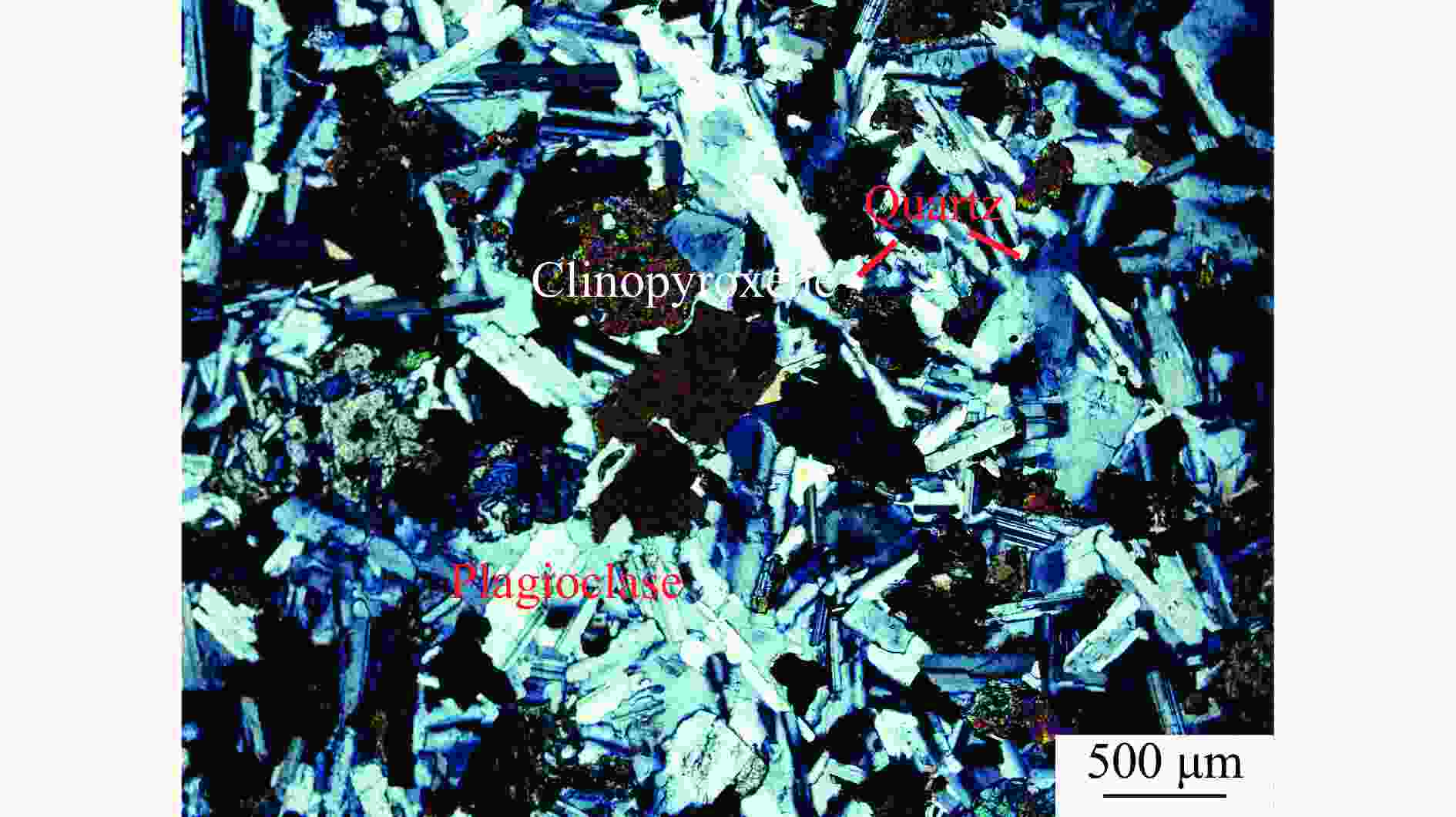
 下载:
下载:
